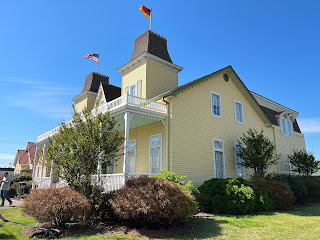We started our day at the Tennessee River Museum in Savannah.
 |
| A true air-breathing MOSASAUR |
 |
The City of Florence, a St. Louis and Tennessee River Packet Company boat, was named to honor the fast-growing city at the foot of Muscle Shoals. Upbound near Coffee Landing on February 8, 1913, she got out of control and was lying cross-stream when the towboat Tomahawk, down-bound and loaded with crossties, rammed and sank her. One member of the crew and a young passenger lost their lives in the accident. The picture below shows a ship with two girls. 12-year-old Ruth Tarbet (left) was one of two casualties of the sinking ship. The daughter of a prominent Saltillo merchant, Ruth, and her daughter had boarded the doomed steamer for the short trip to visit relatives in Savannah. |
 |
| US GRANT HDGS |
 |
| HAGY'S CATFISH HOTEL |
We ate fried catfish, coleslaw, hush puppies, and grilled veggies. Ava ate fried chicken fingers and fries. She said those were the best chicken fingers she had ever eaten, andld our waitress she rate d the food 100. She ate every bite. We took several pictures at the restaurant and near the Tennessee River.
 |
| Garfield's Cabin |
 |
| The History of Garfield Garfield's Cabin If the cabin walls could talk, they would reveal the intriguing story of Garfield Luster, an extraordinary yet excellent resident for many years. The story begins on a hot summer day around 1920 when Mr. Narvin Hagy, a local traveling salesman, gives Garfield a ride. During this time, Garfield worked for a family that had mistreated him for many years. He fled this harsh environment and met Mr. Norvin Hagy on an old gravel road. Mr. Hagy lived on a large farm, bonding with the Shiloh National Military. His parents were Frank and Mary Hagy. Frank, who had grown up on the farm, was 13 when the "Battle of Shiloh" took place around their home in April 1862. Garfield eventually established a close bond with the Hagy family and settled in with them. During the many decades he lived with the Hagy family, he helped care for four generations. He not only cooked but also did laundry and performed other basic household chores, and he helped raise the youngsters—a duty he enjoyed the most. He nurtured the young family of Norvin and Dorothy Hagy, showering them with devotion and care as if they were his own children. But Garfield did more than comfort, console, and, when necessary, scold the children; he could also entertain them. Many years before the fables of Uncle Remus were popularized by Hollywood, Garfield charmed the young Hagys with his folktales of Brer Rabbit and Brer Fox. Another of his talents was acting. He could dress up as a comical character called "Aunt Emiley" and play her so convincingly that the children would momentarily forget they were watching Garfield in disguise. One of Garfield's favorite stories was about how he got his name. He always chuckled when he recounted how it was bestowed upon him following the assassination of President Garfield. Like his namesake, Garfield experienced hard times. He refused to dwthought thehad enough occasion to recall his unhappy childhood. Garfield was born and raised in the small rural community of Red Bay, North Alabama, likely the son of a former slave. Garfield was deprived of a formal education, although he was brilliant and could have excelled in school if given the opportunity. Even though he was not articulate, his speech was folksy Southern colloquialismsuthern colmolasses,oor naillue blazes, sharp as a tack, strong as an ox, to quote a few. King Kong 911 1h Garfield lived a long and happy life in Shiloh with the Hagy family. However, he suffered much bereavement at the death of Norvin Hagy in 1960, never fully recovering from the loss of a man who had provided a sanctuary for the more significant part of his life. Shortly after Mr. Hagy died in 1961, Garfield was diagnosed with prostate cancer. During the last weeks of his life, Norvin Hagy Jr and his wife, Teke, took Garfield home for a final visit with his relatives, who, at the time, were living in Mississippi. After his funeral at his church, Saint Rest in Guys, Tennessee, attended by the Hagy Family, Garfield was laid to rest in a small grove of trees. The Hagys will always remember Garfield with great love and gratitude as a person who enriched their lives. By: the Hagy Family Dr Don Hagy/Dean Hagy |
Next, we stopped at Shiloh Battlefield. The museum was closed for repairs, but you could watch a film there. We did not stay to watch the movie. We heard gunfire and went to investigate.
 |
| Young Park Ranger giving a demonstration. |
 |
| Park Ranger talking to Ava about being a nurse in the Civil War |
 |
| Shiloh Log Church |





























